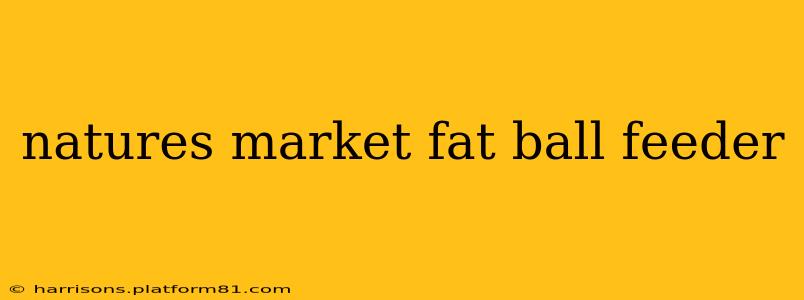Are you looking to attract feathered friends to your garden? A fat ball feeder, particularly one from Nature's Market, can be a fantastic way to provide birds with essential nutrients and enjoy their vibrant presence up close. This guide delves into everything you need to know about Nature's Market fat ball feeders, addressing common questions and offering expert advice for optimal use.
What is a Nature's Market Fat Ball Feeder?
Nature's Market offers a range of bird feeders, and their fat ball feeders are designed to dispense high-energy suet or fat balls. These feeders typically feature a cage-like structure to protect the fat balls from larger birds and squirrels while allowing smaller birds easy access. The specific design may vary depending on the model, but they generally prioritize ease of use, cleaning, and durability. The quality of materials and design ensures the feeder can withstand various weather conditions.
What types of fat balls are best for Nature's Market feeders?
While Nature's Market itself likely doesn't produce fat balls, their feeders are compatible with most commercially available fat balls. Look for fat balls that are specifically formulated for different bird species, catering to their dietary needs. Some fat balls contain added seeds, nuts, or insects, offering a more varied and nutritious meal. Avoid fat balls containing additives that might be harmful to birds. Always choose high-quality fat balls from reputable brands to ensure your feathered friends receive a balanced diet.
How do I clean a Nature's Market fat ball feeder?
Regular cleaning is crucial to prevent the spread of disease among birds. To clean your Nature's Market fat ball feeder, first, remove any remaining fat balls. Then, wash the feeder thoroughly with warm, soapy water. Avoid using harsh chemicals or detergents. Rinse thoroughly and allow the feeder to air dry completely before refilling it with fresh fat balls. It’s a good idea to clean your feeder at least once a month, or more frequently during periods of wet weather.
Where should I place a Nature's Market fat ball feeder?
Placement is key for attracting birds and ensuring the feeder's safety. Ideally, position your Nature's Market fat ball feeder in a sheltered location, away from direct sunlight and rain. This helps prevent the fat balls from melting or becoming soggy. Choose a spot that offers birds a clear approach and escape route, away from potential predators like cats. Consider placing the feeder near shrubs or trees to provide extra protection. Visibility is also important; birds are more likely to discover the feeder if it's easily visible from various angles.
How often should I refill a Nature's Market fat ball feeder?
The frequency of refilling depends on the size of the feeder and the number of birds visiting it. Monitor your feeder regularly and refill it as needed, ensuring there's always a supply of fat balls available. During colder months, when birds require more energy, you might need to refill the feeder more frequently. Aim to keep the feeder consistently stocked, especially during harsh weather conditions.
Are Nature's Market fat ball feeders squirrel-proof?
While many fat ball feeders offer some protection against squirrels, it's important to manage expectations. Highly determined squirrels might find ways to access the fat balls. Choosing a feeder with a robust cage and small openings can help deter squirrels. You can further reduce the risk by placing the feeder in a location where squirrels have difficulty reaching it, or by incorporating additional squirrel-deterrent measures.
What are the benefits of using a Nature's Market fat ball feeder?
Using a fat ball feeder offers several benefits. Primarily, it provides birds with a vital source of high-energy food, particularly important during winter months. It allows for close observation of birds in your garden, offering a rewarding wildlife experience. Moreover, a well-maintained feeder supports local bird populations and contributes to biodiversity.
This comprehensive guide provides valuable information on Nature's Market fat ball feeders and how to maximize their effectiveness in attracting and supporting birds in your garden. Remember to choose high-quality fat balls, maintain a clean feeder, and select an optimal location for the best results.
